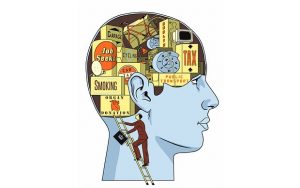To nudge is to encourage or to persuade someone to do something in a way for wanting the aimed result. Nudging is done gently rather than forcefully. Nudging is always done subtly to encourage people to make decisions that are in their broad self-interest. Richard Thaler and Cass Sunstein wrote their book Nudge, which was published in 2008, in which they wrote the Nudge theory. ‘Nudging’, refers to altering the decision-making environment in the context of biases and ‘irrational’ behaviour that decision-makers often display.
A recent study found that when a subject at school was called “geometry” boys performed significantly better than girls. However, when it was called “drawing figures” both genders performed equally. A simple change in the terminology of the curriculum led to a significant difference in performance! This represents nudging at its most innovative form. Pictures of police officers in shop windows tend to discourage theft. Also, there’s the famous image of a fly on urinals which encourages its users to better aim their urinal flow. The evidence is that it works.
A good recent example can be found in UK pension policy. In the past, many workers missed out on valuable pension benefits, because their employer didn’t offer them a pension or they didn’t apply to join their company’s pension scheme. Automatic enrollment changed this. It made it compulsory for employers to automatically enroll their eligible workers into a pension scheme. The employer must also pay money into the scheme. In order to increase worryingly low pension saving rates among private sector workers the Government mandated employers to establish an “automatic enrollment” scheme in 2012. This meant that workers would be automatically placed into a firm’s scheme, and contributions would be deducted from their pay packet, unless they formally requested to be exempted.
Israel and Singapore have benefited from interventions that target predictable behaviour of individuals. Predictive Patient Management through Contactless Vitals Monitoring from Hospital to Home In this joint project, both Israeli and Singapore companies aim to develop a contactless monitoring system to monitor bio-parameters such as heart rate, respiration rate, heart rate variability, heart and lung sounds and blood pressure. The solution could be used independently by the patient. The Israeli partner will develop the vitals monitoring system and the sensors while the Singapore partner will integrate its AI solution with the monitoring system and conduct the clinical trials including following up with the patients. In Singapore it is called HealthHub.
In India, common public health and hygiene problems relate to open defecation, public urination, and poor civic sense when it comes to littering. Prime Minister Narendra Modi’s Swachh Bharat Abhiyan used a lot of nudging for tackling the problem; actor Vidya Balan was roped in to appeal to the rural households to build toilets. The Indian Government Think Tank NITI Ayog brought behavioral economists and advertising gurus on board to sensitize people at the grassroots towards the government’s flagship programs such as Swachh Bharat, Jan Dhan Yojana, Digital India and Skill Development through social messaging and new ad campaigns. NITI Ayog has tied up with the Bill & Melinda Gates Foundation to set up a ‘nudge unit’ that will work towards bringing about behavioral changes and recommending policy corrections to help make the programs more effective.
Various interventions around the world have attempted to tackle poor sanitary practices as well as littering. In India, one idea to prevent public urination which is believed to be widespread but no consistent data is available. A common way of preventing it is by painting religious and/or cultural images; this is a precise example of nudging. Nudge theory can also be used to explore, understand, and explain existing influences on how people behave. It also helps in understanding which messages are unhelpful, with a view to removing or altering them. There are lots of these unhelpful ‘nudges’ everywhere, notably in advertising and government, some unintentional.
Globally, there are several practical examples of nudging. In England, a simple change of language and visuals in official communication tripled the collection of vehicle taxes. In Denmark, a simple change of signage reduced littering by 46%. Another example includes, reduced energy consumption among Americans by sharing with the consumers their neighbor’s consumption pattern. Nudging has helped Americans in increased college enrollment, and improved academic performance. Former US President Barack Obama also tried this approach by increasing contribution in the 401 (k) retirement schemes; this intervention boosted annual savings by $7 billion! Nudge theory is a radically different and more sophisticated approach to achieving change in people than traditional methods of direct instruction, enforcement, punishment, etc.
The use of Nudge theory is based on indirect encouragement and enablement. It avoids direct instruction or enforcement. It is mainly concerned with the design of choices, which influences the decisions we make. Nudge theory proposes that the designing of choices should be based on how people actually think and decide instinctively, rather than how leaders and authorities traditionally and often incorrectly believe people think and decide. Nudge theory seeks to improve understanding and management of the ‘heuristic’ (enabling people to learn something about themselves) influences on human behaviour. See how US spells behaviour as ‘behavior’, which is central to ‘changing’ people.
In Guatemala, the government sent tax reminder letters to citizens saying that 64.5% of their fellow citizens had declared their income tax on time. This led to a 43% increase in payments in just 11 weeks. Moreover, the effect of the new letter was not just one of those; it helped in increasing tax revenues in the long-term. The effects are persistent. The Guatemala experiment proves that the letters actually increased revenue for the tax authority, rather than just bringing tax receipts forward. The experiment was a replication of an earlier trial in the UK, which demonstrates how there are common approaches that can be taken across different nations.
What about ‘nudging’ people to go for healthier food and drink choices? Behavioural Insights Team in Australia conducted a trial to find out the impact of a 20% price increase on sugar-sweetened drinks in some of the country’s hospitals. Results showed that there was a “significant” 44% reduction in the number of sugary drinks sold. If citizens have more information on their personal health, they will take ownership over their well being; which will translate into less strain on the healthcare system. This was the thinking behind Singapore’s new Health Hub, an online platform that allows people to access their online health records from public hospitals and clinics.
Across the world, governments are seeing the benefits of applying behavioural science to improving services, environments, and lives. With the right evidence at hand, small and often inexpensive changes can have a big impact. The strategy is credited for boosting tax payments, attracting army/navy/air force and police recruitment, healthcare, prevention of drugs, prevention of women and children abuse, motivating organ donors, environment betterment etc. No wonder, more than a dozen countries have set up offices called “Nudge units” to lead experiments using behavioral science.















































